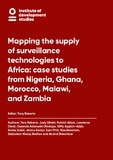| dc.contributor.author | Roberts, Tony | |
| dc.contributor.author | Gitahi, Judy | |
| dc.contributor.author | Allam, Patrick | |
| dc.contributor.author | Oboh, Lawrence | |
| dc.contributor.author | Oladapo, Oyewole | |
| dc.contributor.author | Appiah-Adjei, Gifty | |
| dc.contributor.author | Galal, Amira | |
| dc.contributor.author | Kainja, Jimmy | |
| dc.contributor.author | Phiri, Sam | |
| dc.contributor.author | Abraham, Kiss | |
| dc.contributor.author | Klovig Skelton, Sebastian | |
| dc.contributor.author | Sheombar, Anand | |
| dc.date.accessioned | 2023-09-25T09:23:06Z | |
| dc.date.available | 2023-09-25T09:23:06Z | |
| dc.date.issued | 2023-09-25 | |
| dc.identifier.citation | Roberts, T. et al. (2023) Mapping the Supply of Surveillance Technologies to Africa: Case Studies from Nigeria, Ghana, Morocco, Malawi, and Zambia, Brighton: Institute of Development Studies, DOI: 10.19088/IDS.2023.027 | en |
| dc.identifier.uri | https://opendocs.ids.ac.uk/opendocs/handle/20.500.12413/18120 | |
| dc.description.abstract | African governments are spending over 1US$bn per year on digital surveillance technologies which are being used without adequate legal protections in ways that regularly violate citizens’ fundamental human rights. This report documents which companies, from which countries, are supplying which types of surveillance technology to African governments. Without this missing detail, it is impossible to adequately design measures to mitigate and overcome illegal surveillance and violations of human rights.
Since the turn of the century, we have witnessed a digitalisation of surveillance that has enabled the algorithmic automation of surveillance at a scale not previously imaginable. Surveillance of citizens was once a labour and time-intensive process. This provided a practical limit to the scope and depth of state surveillance. The digitalisation of telephony has made it possible to automate the search for keywords across all mobile and internet communications. For the first time, state surveillance agencies can do two things: (a) conduct mass surveillance of all citizens’ communications, and (b) micro-target individuals for in-depth surveillance that draws together in real-time data from mobile calls, short message service (SMS), internet messaging, global positioning system (GPS) location, and financial transactions.
This report was produced by qualitative analysis of open-source data in the public domain. The information presented is drawn from a diverse range of sources, including open government data sets, export licence portals, procurement notices, civil society databases of surveillance contracts, press releases from surveillance companies, academic articles, reports, and media coverage.
The research is organised using a typology of five categories of surveillance technology. We did not set out to detail every technology available, every company, or every supply contract. Instead, we document the main companies and countries selling digital surveillance technologies to African governments. Rather than focus on the technical functionality distinguishing each product offering, we highlight five of the most important types of surveillance technology: internet interception, mobile interception, social media surveillance, ‘safe city’ technologies for the surveillance of public spaces, and biometric identification technologies. | en |
| dc.description.sponsorship | Civic Futures | en |
| dc.language.iso | en | en |
| dc.publisher | Institute of Development Studies | en |
| dc.rights.uri | http://creativecommons.org/licenses/by/4.0/ | en |
| dc.title | Mapping the Supply of Surveillance Technologies to Africa: Case Studies from Nigeria, Ghana, Morocco, Malawi, and Zambia | en |
| dc.rights.holder | Institute of Development Studies | en |
| dc.identifier.doi | 10.19088/IDS.2023.027 | |
| rioxxterms.funder | Default funder | en |
| rioxxterms.identifier.project | Default project | en |
| rioxxterms.version | VoR | en |
| rioxxterms.versionofrecord | 10.19088/IDS.2023.027 | en |
| rioxxterms.funder.project | e4b8632d-62dd-4f31-9936-43860ac26f9a | en |









